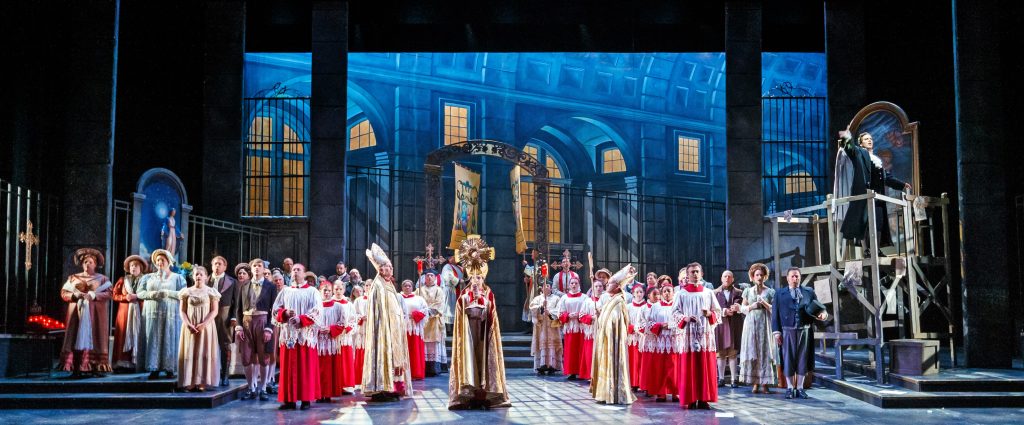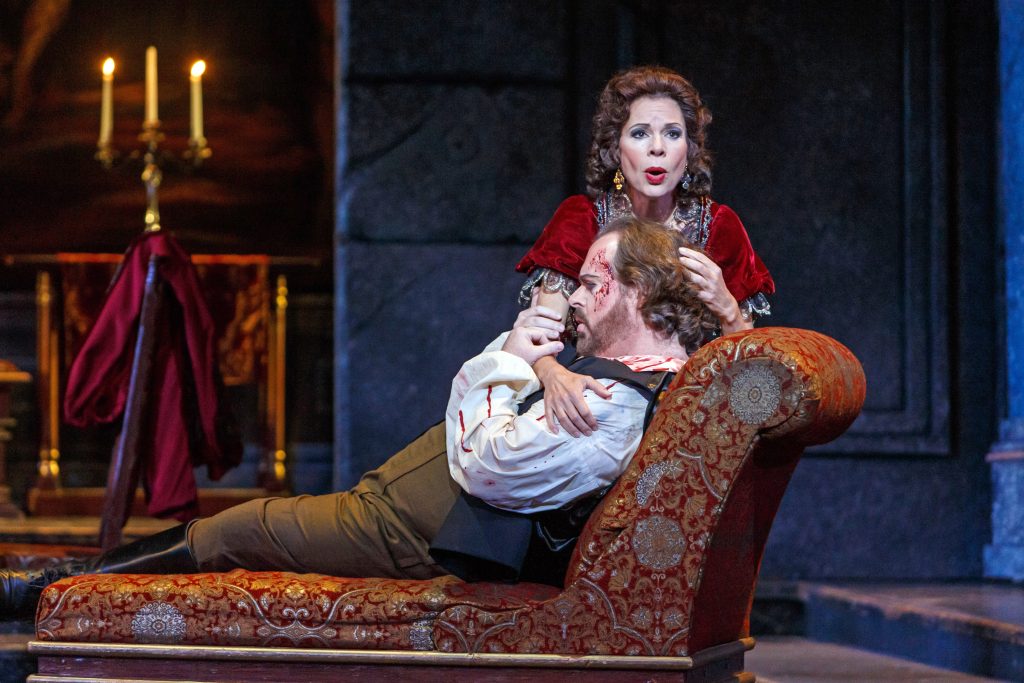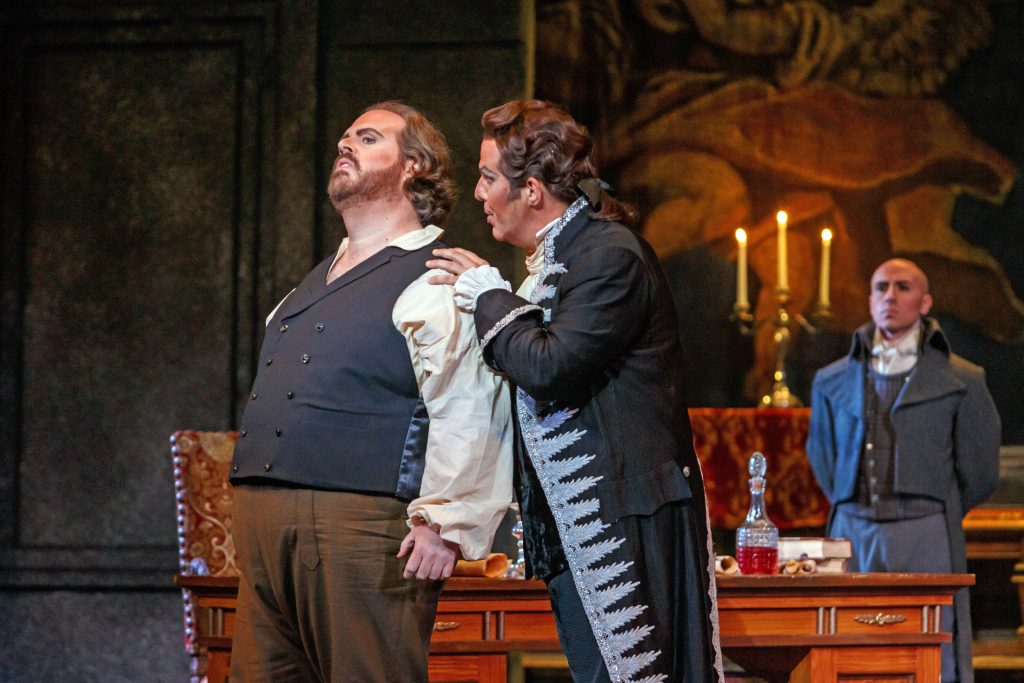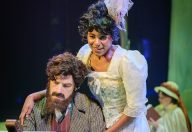Pittsburgh Opera’s Terrific ‘Tosca’ Makes A Tasty Treat

Pittsburgh Opera’s production of Tosca offers a stunning tableau of dramatic contrasts. As Sant’Andrea’s Te Deum devoutly begins, Baron Scarpia (on scaffold) unleashes his vile scheme.
One of the delights of opera is that most plots are simple. Classic opera tends toward pure melodrama. The hero rescues his love interest and vanquishes the villain. The formula is to be expected as tradition because it can be as comforting as macaroni and cheese or meatloaf and mashed potatoes. Either can be made more interesting with, perhaps, some crisp bacon, or a dash of hot sauce. But the basic recipe should offer no surprise unto itself. And, yet, TOSCA, Puccini’s classic opera about a diva who must rescue her lover, is a story baked in a very different oven. And it’s decidedly delicious. Pittsburgh Opera’s Tosca is onstage at Benedum Center through October 13.
Intriguing Entrees
Why? One reason is the entire storyline takes place in less than 24-hours. That dramatic conceit is not meant to drive the action. No bomb will explode if not diffused in less than seven minutes; no young princess is doomed to become an ugly hag at the stroke of midnight. Rather, the clock is employed to frame the tragedy of the story. The entire course of events takes place from one day to early dawn of the next as if to express to the audience “Can you believe this all could unfold so quickly?” It’s not so much a question as it is an exclamation. And that makes the story of Tosca all the more compelling. Sure, there are lively, lingering arias that dwell on love and yearning, and contrasting duets that confirm conflicts of character. But no one is rushing to the final act. Yet, once the audience gets there, well, it’s rather impressive to consider all that’s happened.

Diva Floria Tosca (Ana María Martínez) comforts her lover Cavaradossi (Jonathan Burton), confessing her resolve to his intended fate: death by firing squad.
A second reason is character. In storybook melodrama, the heroine is sweet and innocent and the villain is dark and mean-spirited. For example, sweet, innocent Nell is tied to the railroad tracks by Snidely Whiplash only because that’s what villains do. Nell cries for anyone’s help. Dudley Do-Right “does right” by Nell, not for love but because she’s in danger. (Actually, Nell loves Dudley’s horse, but that’s getting off track.) In Tosca, however, Puccini’s characters are all fully expressed. The diva, Floria Tosca, is a true “diva” by modern denotation. She well might love the painter Cavaradossi, but, boy, is she jealous of his attention. She has enormous faith in the Madonna, but not much trust in her artist-lover. Yet, as the formula for melodrama begs, she does everything in her powers to rescue him. And of the dastardly Baron Scarpia, our story’s necessary villain, the “V” stands for vile. Justice nor revenge have anything to do with his motives. Lechery and lust drives his libido for which the audience has real reason to hate him. And that makes this operatic dish of love and lust, of faith and fidelity, all the more tasty.
A Recipe for Revenge
Of course, there’re many more reasons to love Tosca, but for those unfamiliar with Puccini’s opera (first performed in 1900 and tangentially based on historic events of 1800), the drama unfolds when the artist Mario Cavaradossi, while painting a portrait of Mary Magdalene in the church of Sant’Andrea della Valle, is confronted by Cesare Angelotti, an escaped prisoner hiding in the chapel. They are old friends and, as such, Cavaradossi intends to keep him safe. Even when his lover, Floria Tosca, the beloved diva of the Roman town arrives, Angelotti’s hiding is kept a secret. Naturally, Tosca becomes suspicious. Is Cavaradossi hiding something? Why does the portrait of Madonna not look more like Tosca herself? And just who did model for the image Cavaradossi is now painting? Her jealousy is both jarring and jaw-dropping. Tosca exits before Cavaradossi slips Angelotti away to safer hiding grounds. Seconds later, Baron Scarpia, chief of the secret police, and his henchmen, Spoletta and Sciarrone, rush into the church to seek the escaped prisoner. Scarpia discovers a woman’s fan. When Tosca returns to the church, Scarpia shows her the evidence that Cavaradossi must be hiding something. As he himself is in love with Tosca, Scarpia begins to scheme that he can turn her away from Cavaradossi, uncover the truth, and satisfy his infatuation for the diva. The first act ends as a church choir assembles––along with clergy, priests, and a cardinal––to celebrate their faith, an act against which Puccini cleverly juxtaposes the rampant jealousy both Scarpia and Tosca are each wont to show.
Satisfaction Sated

Painter Caravadossi (Jonathan Burton) is repulsed by Baron Scarpia’s (Kyle Albertson) accusations of subterfuge; his henchman Spoletto (Fran Daniel Laucerica) awaits orders to torture the artist.
Performing the role of Cavaradossi is tenor Jonathan Burton, a passionate and powerful voice with which he commands both attention and sympathy in this demanding role. Baritone Erik Nordstrom makes his Pittsburgh Opera debut in the role of the escapee, Angelotti. Necessarily, his appearance is brief, but memorable. As Floria Tosca, Ana María Martínez owns the stage, both deliberate in her range and polished in presentation. This, too, is her debut with the Pittsburgh Opera, despite a significant career with the Los Angeles Opera and many other companies. A Grammy winner, she is also a Professor of Voice at Rice University, both professional acclamations evidenced by her incredible performance. Perhaps most impressive is baritone Kyle Albertson as Baron Scarpia. His villainous role, of course, is over the top, but Albertson carries it with refined composure and breath-taking energy. Two more performers are worth great applause. As the church sacristan, Brian Kontes brings a purposeful humility to his baritone, truly befitting his stage role. And, as Spoletta, Fran Daniel Laucerica is riveting as Scarpia’s obedient sidekick. His tenor voice is only overshadowed by his authoritative stage presence. Like many classic operas, there are also many, too many supporting voices to mention. The Pittsburgh Opera does not shy away from filling the stage, in this case with military guards, choristers, and a full clergy, not to mention passers-by, court attendees, judges and jury. They deserve much of the applause for a spectacular production.

Tosca (Martínez) turns the tables on Baron Scarpia (Albertson) who must beg for his own miserable life.
Exceptional Contributors
Tosca unfolds in three acts, each set in a distinct location as the action drives on to an early morning showdown. The scenery for this production is truly stunning, and, although constructed by the Lyric Opera of Kansas City, appears as if designed for the Benedum stage. Keith Brumley, set designer, earns great accolades, as does lighting designer Abigail Hoke-Brady for affecting the ebb and flow of daylight with appropriate subtlety. Costumer Andrew Marley whose designs originated for the New York City Opera production of Tosca presents some remarkable work, particularly with Baron Scarpia. The Pittsburgh audience may have noted, too, the “holy” iridescence of the clergy’s robes and miters.
Tara Faircloth directed this Pittsburgh stage with evident attention to blocking and movement. For example, Act Two, in which Scarpia plays on Tosca’s distress requires both characters to sweep from left to right, and back again, as Caravadossi’s torture is heard offstage. Simply stated, the scene is choreographed magnificently. As if saving the best for last, the Pittsburgh Opera Orchestra is always, and again, a highlight of every production. Conductor Antony Walker is a star among sixty-four credited musicians for Tosca.
With music by Giacomo Puccini and a libretto by Luigi Illica and Giuseppe Giacosa, Pittsburgh’s production of Tosca is stage managed by Cindy Knight, with the assistance of Bee Anderson and Tess Naval. Dana Kinney assisted in stage direction. James Geier designed the wigs and make-up. Tonya R. Lynn directed the fight scene with assistance from Anne Ramatt. Assistant Conductor is Glenn Lewis, Chorus Master is Mark Trawka, and associate coach and pianist is James Lesniak, who worked along with resident artist pianist, Maeve Berry. Performances of Tosca will carry forward on October 8, 11, and 13 at Benedum Center, Cultural District, Downtown.
Photos: David Bachman Photography for Pittsburgh Opera.
C. Prentiss Orr is a Pittsburgh-based writer who covers theater and other topics for Entertainment Central. He is the author of the books The Surveyor and the Silversmith and Pittsburgh Born, Pittsburgh Bred.
Share on Social Media
Follow Entertainment Central
Latest Stories
Sign up for the EC Newsletter







